- Texas Go Math
- Big Ideas Math
- Engageny Math
- McGraw Hill My Math
- enVision Math
- 180 Days of Math
- Math in Focus Answer Key
- Math Expressions Answer Key
- Privacy Policy

Eureka Math Grade 8 Module 4 Lesson 1 Answer Key
Engage ny eureka math 8th grade module 4 lesson 1 answer key, eureka math grade 8 module 4 lesson 1 exercise answer key.
Write each of the following statements using symbolic language.
Exercise 1. The sum of four consecutive even integers is -28. Answer: Let x be the first even integer. Then, x+x+2+x+4+x+6=-28.
Exercise 2. A number is four times larger than the square of half the number. Answer: Let x be the number. Then, x=4(\(\frac{x}{2}\)) 2 .
Exercise 3. Steven has some money. If he spends $9.00, then he will have \(\frac{3}{5}\) of the amount he started with. Answer: Let x be the amount of money (in dollars) Steven started with. Then, x-9=\(\frac{3}{5}\) x.
Exercise 4. The sum of a number squared and three less than twice the number is 129. Answer: Let x be the number. Then, x 2 +2x-3=129.
Exercise 5. Miriam read a book with an unknown number of pages. The first week, she read five less than \(\frac{1}{3}\) of the pages. The second week, she read 171 more pages and finished the book. Write an equation that represents the total number of pages in the book. Answer: Let x be the total number of pages in the book. Then, \(\frac{1}{3}\) x-5+171=x.
Eureka Math Grade 8 Module 4 Lesson 1 Problem Set Answer Key
Students practice transcribing written statements into symbolic language.
Question 1. Bruce bought two books. One book costs $4.00 more than three times the other. Together, the two books cost him $72. Answer: Let x be the cost of the less expensive book. Then, x+4+3x=72.
Question 2. Janet is three years older than her sister Julie. Janet’s brother is eight years younger than their sister Julie. The sum of all of their ages is 55 years. Answer: Let x be Julie’s age. Then, (x+3)+(x-8)+x=55.
Question 3. The sum of three consecutive integers is 1,623. Answer: Let x be the first integer. Then, x+(x+1)+(x+2)=1623.
Question 4. One number is six more than another number. The sum of their squares is 90. Answer: Let x be the smaller number. Then, x 2 +(x+6) 2 =90.
Question 5. When you add 18 to \(\frac{1}{4}\) of a number, you get the number itself. Answer: Let x be the number. Then, \(\frac{1}{4}\) x+18=x.
Question 6. When a fraction of 17 is taken away from 17, what remains exceeds one-third of seventeen by six. Answer: Let x be the fraction of 17. Then, 17-x=\(\frac{1}{3}\)∙17+6.
Question 7. The sum of two consecutive even integers divided by four is 189.5. Answer: Let x be the first even integer. Then, \(\frac{x+(x+2)}{4}\)=189.5.
Question 8. Subtract seven more than twice a number from the square of one-third of the number to get zero. Answer: Let x be the number. Then, (\(\frac{1}{3}\) x) 2 -(2x+7)=0.
Question 9. The sum of three consecutive integers is 42. Let x be the middle of the three integers. Transcribe the statement accordingly. Answer: (x-1)+x+(x+1)=42
Eureka Math Grade 8 Module 4 Lesson 1 Exit Ticket Answer Key
Question 1. When you square five times a number, you get three more than the number. Answer: Let x be the number. Then, (5x) 2 =x+3.
Question 2. Monica had some cookies. She gave seven to her sister. Then, she divided the remainder into two halves, and she still had five cookies left. Answer: Let x be the original amount of cookies. Then, \(\frac{1}{2}\) (x-7)=5.
Leave a Comment Cancel Reply
You must be logged in to post a comment.

- school Campus Bookshelves
- menu_book Bookshelves
- perm_media Learning Objects
- login Login
- how_to_reg Request Instructor Account
- hub Instructor Commons
- Download Page (PDF)
- Download Full Book (PDF)
- Periodic Table
- Physics Constants
- Scientific Calculator
- Reference & Cite
- Tools expand_more
- Readability
selected template will load here
This action is not available.

8.4: Chapter 8 Review Exercises
- Last updated
- Save as PDF
- Page ID 66404

Chapter Review Exercises
Distance and midpoint formulas; circles, exercise \(\pageindex{1}\) use the distance formula.
In the following exercises, find the distance between the points. Round to the nearest tenth if needed.
- \((-5,1)\) and \((-1,4)\)
- \((-2,5)\) and \((1,5)\)
- \((8,2)\) and \((-7,-3)\)
- \((1,-4)\) and \((5,-5)\)
4. \(d=\sqrt{17}, d \approx 4.1\)
Exercise \(\PageIndex{2}\) Use the Midpoint Formula
In the following exercises, find the midpoint of the line segments whose endpoints are given.
- \((-2,-6)\) and \((-4,-2)\)
- \((3,7)\) and \((5,1)\)
- \((-8,-10)\) and \((9,5)\)
- \((-3,2)\) and \((6,-9)\)
2. \((4,4)\)
4. \(\left(\frac{3}{2},-\frac{7}{2}\right)\)
Exercise \(\PageIndex{3}\) Write the Equation of a Circle in Standard Form
In the following exercises, write the standard form of the equation of the circle with the given information.
- radius is \(15\) and center is \((0,0)\)
- radius is \(\sqrt{7}\) and center is \((0,0)\)
- radius is \(9\) and center is \((-3,5)\)
- radius is \(7\) and center is \((-2,-5)\)
- center is \((3,6)\) and a point on the circle is \((3,-2)\)
- center is \((2,2)\) and a point on the circle is \((4,4)\)
2. \(x^{2}+y^{2}=7\)
4. \((x+2)^{2}+(y+5)^{2}=49\)
6. \((x-2)^{2}+(y-2)^{2}=8\)
Exercise \(\PageIndex{4}\) Graph a Circle
In the following exercises,
- Find the center and radius, then
- Graph each circle.
- \(2 x^{2}+2 y^{2}=450\)
- \(3 x^{2}+3 y^{2}=432\)
- \((x+3)^{2}+(y-5)^{2}=81\)
- \((x+2)^{2}+(y+5)^{2}=49\)
- \(x^{2}+y^{2}-6 x-12 y-19=0\)
- \(x^{2}+y^{2}-4 y-60=0\)
- radius: \(12,\) center: \((0,0)\)
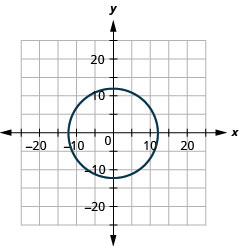
- radius: \(7,\) center: \((-2,-5)\)
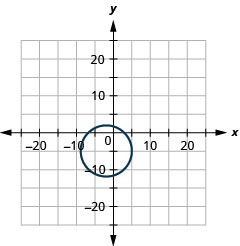
- radius: \(8,\) center: \((0,2)\)
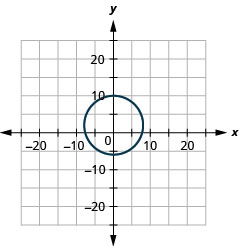
Exercise \(\PageIndex{5}\) Graph Vertical Parabolas
In the following exercises, graph each equation by using its properties.
- \(y=x^{2}+4 x-3\)
- \(y=2 x^{2}+10 x+7\)
- \(y=-6 x^{2}+12 x-1\)
- \(y=-x^{2}+10 x\)
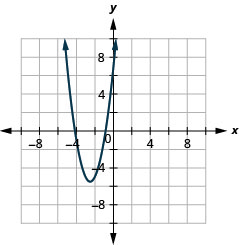
Exercise \(\PageIndex{6}\) Graph Vertical Parabolas
- Write the equation in standard form, then
- Use properties of the standard form to graph the equation.
- \(y=x^{2}+4 x+7\)
- \(y=2 x^{2}-4 x-2\)
- \(y=-3 x^{2}-18 x-29\)
- \(y=-x^{2}+12 x-35\)
- \(y=2(x-1)^{2}-4\)
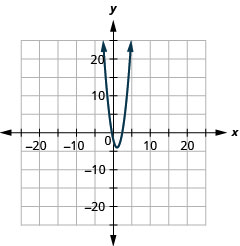
- \(y=-(x-6)^{2}+1\)
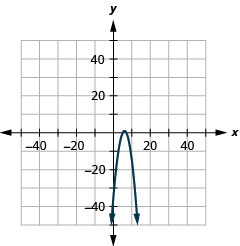
Exercise \(\PageIndex{7}\) Graph Horizontal Parabolas
- \(x=2 y^{2}\)
- \(x=2 y^{2}+4 y+6\)
- \(x=-y^{2}+2 y-4\)
- \(x=-3 y^{2}\)
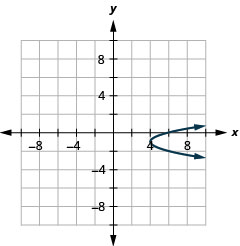
Exercise \(\PageIndex{8}\) Graph Horizontal Parabolas
- \(x=4 y^{2}+8 y\)
- \(x=y^{2}+4 y+5\)
- \(x=-y^{2}-6 y-7\)
- \(x=-2 y^{2}+4 y\)
- \(x=(y+2)^{2}+1\)
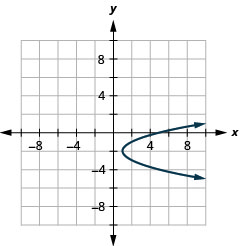
- \(x=-2(y-1)^{2}+2\)
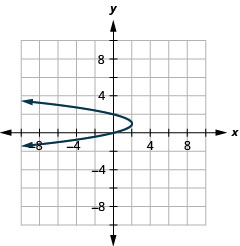
Exercise \(\PageIndex{9}\) Solve Applications with Parabolas
In the following exercises, create the equation of the parabolic arch formed in the foundation of the bridge shown. Give the answer in standard form.

2. \(y=-\frac{1}{9} x^{2}+\frac{10}{3} x\)
Exercise \(\PageIndex{10}\) Graph an Ellipse with Center at the Origin
In the following exercises, graph each ellipse.
- \(\frac{x^{2}}{36}+\frac{y^{2}}{25}=1\)
- \(\frac{x^{2}}{4}+\frac{y^{2}}{81}=1\)
- \(49 x^{2}+64 y^{2}=3136\)
- \(9 x^{2}+y^{2}=9\)

Exercise \(\PageIndex{11}\) Find the Equation of an Ellipse with Center at the Origin
In the following exercises, find the equation of the ellipse shown in the graph.
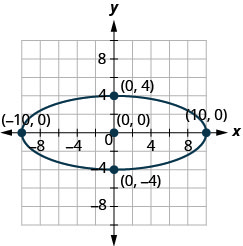
2. \(\frac{x^{2}}{36}+\frac{y^{2}}{64}=1\)
Exercise \(\PageIndex{12}\) Graph an Ellipse with Center Not at the Origin
- \(\frac{(x-1)^{2}}{25}+\frac{(y-6)^{2}}{4}=1\)
- \(\frac{(x+4)^{2}}{16}+\frac{(y+1)^{2}}{9}=1\)
- \(\frac{(x-5)^{2}}{16}+\frac{(y+3)^{2}}{36}=1\)
- \(\frac{(x+3)^{2}}{9}+\frac{(y-2)^{2}}{25}=1\)
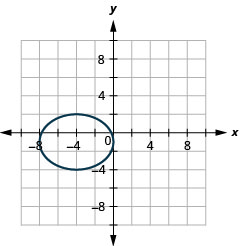
Exercise \(\PageIndex{13}\) Graph an Ellipse with Center Not at the Origin
- Write the equation in standard form and
- \(x^{2}+y^{2}+12 x+40 y+120=0\)
- \(25 x^{2}+4 y^{2}-150 x-56 y+321=0\)
- \(25 x^{2}+4 y^{2}+150 x+125=0\)
- \(4 x^{2}+9 y^{2}-126 x+405=0\)
- \(\frac{(x-3)^{2}}{4}+\frac{(y-7)^{2}}{25}=1\)
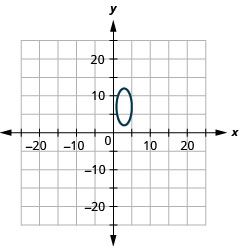
- \(\frac{x^{2}}{9}+\frac{(y-7)^{2}}{4}=1\)
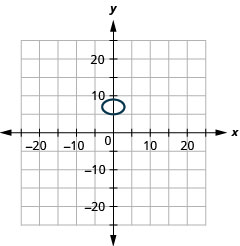
Exercise \(\PageIndex{14}\) Solve Applications with Ellipses
In the following exercises, write the equation of the ellipse described.
- A comet moves in an elliptical orbit around a sun. The closest the comet gets to the sun is approximately \(10\) AU and the furthest is approximately \(90\) AU. The sun is one of the foci of the elliptical orbit. Letting the ellipse center at the origin and labeling the axes in AU, the orbit will look like the figure below. Use the graph to write an equation for the elliptical orbit of the comet.
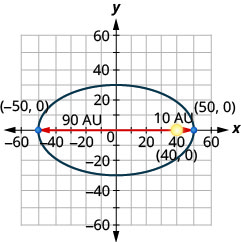
Exercise \(\PageIndex{15}\) Graph a Hyperbola with Center at \((0,0)\)
In the following exercises, graph.
- \(\frac{x^{2}}{25}-\frac{y^{2}}{9}=1\)
- \(\frac{y^{2}}{49}-\frac{x^{2}}{16}=1\)
- \(9 y^{2}-16 x^{2}=144\)
- \(16 x^{2}-4 y^{2}=64\)
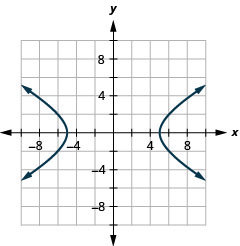

Exercise \(\PageIndex{16}\) Graph a Hyperbola with Center at \((h,k)\)
- \(\frac{(x+1)^{2}}{4}-\frac{(y+1)^{2}}{9}=1\)
- \(\frac{(x-2)^{2}}{4}-\frac{(y-3)^{2}}{16}=1\)
- \(\frac{(y+2)^{2}}{9}-\frac{(x+1)^{2}}{9}=1\)
- \(\frac{(y-1)^{2}}{25}-\frac{(x-2)^{2}}{9}=1\)
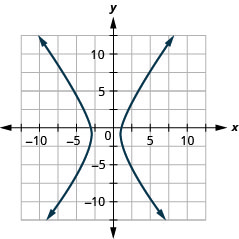
Exercise \(\PageIndex{17}\) Graph a Hyperbola with Center at \((h,k)\)
- \(4 x^{2}-16 y^{2}+8 x+96 y-204=0\)
- \(16 x^{2}-4 y^{2}-64 x-24 y-36=0\)
- \(4 y^{2}-16 x^{2}+32 x-8 y-76=0\)
- \(36 y^{2}-16 x^{2}-96 x+216 y-396=0\)
- \(\frac{(x+1)^{2}}{16}-\frac{(y-3)^{2}}{4}=1\)
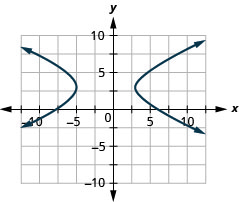
- \(\frac{(y-1)^{2}}{16}-\frac{(x-1)^{2}}{4}=1\)
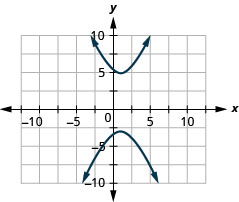
Exercise \(\PageIndex{18}\) Identify the Graph of Each Equation as a Circle, Parabola, Ellipse, or Hyperbola
In the following exercises, identify the type of graph.
- \(16 y^{2}-9 x^{2}-36 x-96 y-36=0\)
- \(x^{2}+y^{2}-4 x+10 y-7=0\)
- \(y=x^{2}-2 x+3\)
- \(25 x^{2}+9 y^{2}=225\)
- \(x^{2}+y^{2}+4 x-10 y+25=0\)
- \(y^{2}-x^{2}-4 y+2 x-6=0\)
- \(x=-y^{2}-2 y+3\)
- \(16 x^{2}+9 y^{2}=144\)
Solve Systems of Nonlinear Equations
Exercise \(\pageindex{19}\) solve a system of nonlinear equations using graphing.
In the following exercises, solve the system of equations by using graphing.
- \(\left\{\begin{array}{l}{3 x^{2}-y=0} \\ {y=2 x-1}\end{array}\right.\)
- \(\left\{\begin{array}{l}{y=x^{2}-4} \\ {y=x-4}\end{array}\right.\)
- \(\left\{\begin{array}{l}{x^{2}+y^{2}=169} \\ {x=12}\end{array}\right.\)
- \(\left\{\begin{array}{l}{x^{2}+y^{2}=25} \\ {y=-5}\end{array}\right.\)

Exercise \(\PageIndex{20}\) Solve a System of Nonlinear Equations Using Substitution
In the following exercises, solve the system of equations by using substitution.
- \(\left\{\begin{array}{l}{y=x^{2}+3} \\ {y=-2 x+2}\end{array}\right.\)
- \(\left\{\begin{array}{l}{x^{2}+y^{2}=4} \\ {x-y=4}\end{array}\right.\)
- \(\left\{\begin{array}{l}{9 x^{2}+4 y^{2}=36} \\ {y-x=5}\end{array}\right.\)
- \(\left\{\begin{array}{l}{x^{2}+4 y^{2}=4} \\ {2 x-y=1}\end{array}\right.\)
1. \((-1,4)\)
3. No solution
Exercise \(\PageIndex{21}\) Solve a System of Nonlinear Equations Using Elimination
In the following exercises, solve the system of equations by using elimination.
- \(\left\{\begin{array}{l}{x^{2}+y^{2}=16} \\ {x^{2}-2 y-1=0}\end{array}\right.\)
- \(\left\{\begin{array}{l}{x^{2}-y^{2}=5} \\ {-2 x^{2}-3 y^{2}=-30}\end{array}\right.\)
- \(\left\{\begin{array}{l}{4 x^{2}+9 y^{2}=36} \\ {3 y^{2}-4 x=12}\end{array}\right.\)
- \(\left\{\begin{array}{l}{x^{2}+y^{2}=14} \\ {x^{2}-y^{2}=16}\end{array}\right.\)
1. \((-\sqrt{7}, 3),(\sqrt{7}, 3)\)
3. \((-3,0),(0,-2),(0,2)\)
Exercise \(\PageIndex{22}\) Use a System of Nonlinear Equations to Solve Applications
In the following exercises, solve the problem using a system of equations.
- The sum of the squares of two numbers is \(25\). The difference of the numbers is \(1\). Find the numbers.
- The difference of the squares of two numbers is \(45\). The difference of the square of the first number and twice the square of the second number is \(9\). Find the numbers.
- The perimeter of a rectangle is \(58\) meters and its area is \(210\) square meters. Find the length and width of the rectangle.
- Colton purchased a larger microwave for his kitchen. The diagonal of the front of the microwave measures \(34\) inches. The front also has an area of \(480\) square inches. What are the length and width of the microwave?
1. \(-3\) and \(-4\) or \(4\) and \(3\)
3. If the length is \(14\) inches, the width is \(15\) inches. If the length is \(15\) inches, the width is \(14\) inches.
Practice Test
Exercise \(\pageindex{23}\).
In the following exercises, find the distance between the points and the midpoint of the line segment with the given endpoints. Round to the nearest tenth as needed.
- \((-4,-3)\) and \((-10,-11)\)
- \((6,8)\) and \((-5,-3)\)
1. distance: \(10,\) midpoint: \((-7,-7)\)
Exercise \(\PageIndex{24}\)
- radius is \(11\) and center is \((0,0)\)
- radius is \(12\) and center is \((10,-2)\)
- center is \((-2,3)\) and a point on the circle is \((2,-3)\)
- Find the equation of the ellipse shown in the graph.
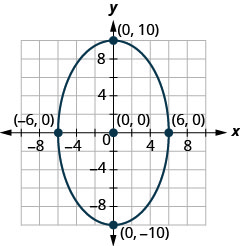
1. \(x^{2}+y^{2}=121\)
3. \((x+2)^{2}+(y-3)^{2}=52\)
Exercise \(\PageIndex{25}\)
- Identify the type of graph of each equation as a circle, parabola, ellipse, or hyperbola, and
- Graph the equation.
- \(4 x^{2}+49 y^{2}=196\)
- \(y=3(x-2)^{2}-2\)
- \(3 x^{2}+3 y^{2}=27\)
- \(\frac{y^{2}}{100}-\frac{x^{2}}{36}=1\)
- \(\frac{x^{2}}{16}+\frac{y^{2}}{81}=1\)
- \(x=2 y^{2}+10 y+7\)
- \(64 x^{2}-9 y^{2}=576\)
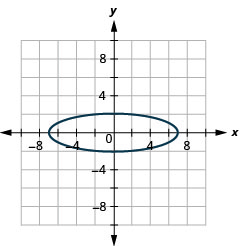
Exercise \(\PageIndex{26}\)
- Identify the type of graph of each equation as a circle, parabola, ellipse, or hyperbola,
- Write the equation in standard form, and
- \(25 x^{2}+64 y^{2}+200 x-256 y-944=0\)
- \(x^{2}+y^{2}+10 x+6 y+30=0\)
- \(9 x^{2}-25 y^{2}-36 x-50 y-214=0\)
- \(y=x^{2}+6 x+8\)
- Solve the nonlinear system of equations by graphing: \(\left\{\begin{array}{l}{3 y^{2}-x=0} \\ {y=-2 x-1}\end{array}\right.\).
- Solve the nonlinear system of equations using substitution: \(\left\{\begin{array}{l}{x^{2}+y^{2}=8} \\ {y=-x-4}\end{array}\right.\).
- Solve the nonlinear system of equations using elimination: \(\left\{\begin{array}{l}{x^{2}+9 y^{2}=9} \\ {2 x^{2}-9 y^{2}=18}\end{array}\right.\)
- Create the equation of the parabolic arch formed in the foundation of the bridge shown. Give the answer in \(y=a x^{2}+b x+c\) form.

10. A comet moves in an elliptical orbit around a sun. The closest the comet gets to the sun is approximately \(20\) AU and the furthest is approximately \(70\) AU. The sun is one of the foci of the elliptical orbit. Letting the ellipse center at the origin and labeling the axes in AU, the orbit will look like the figure below. Use the graph to write an equation for the elliptical orbit of the comet.
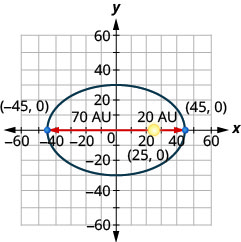
11. The sum of two numbers is \(22\) and the product is \(−240\). Find the numbers.
12. For her birthday, Olive’s grandparents bought her a new widescreen TV. Before opening it she wants to make sure it will fit her entertainment center. The TV is \(55\)”. The size of a TV is measured on the diagonal of the screen and a widescreen has a length that is larger than the width. The screen also has an area of \(1452\) square inches. Her entertainment center has an insert for the TV with a length of \(50\) inches and width of \(40\) inches. What are the length and width of the TV screen and will it fit Olive’s entertainment center?
- \((x+5)^{2}+(y+3)^{2}=4\)
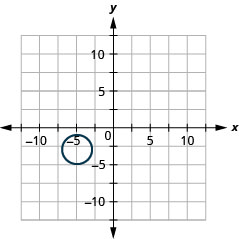
- \(\frac{(x-2)^{2}}{25}-\frac{(y+1)^{2}}{9}=1\)
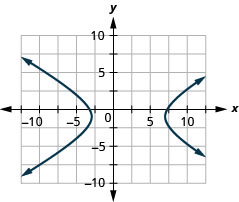
6. No solution
8. \((0,-3),(0,3)\)
10. \(\frac{x^{2}}{2025}+\frac{y^{2}}{1400}=1\)
12. The length is \(44\) inches and the width is \(33\) inches. The TV will fit Olive’s entertainment center.

Home > CC1 > Chapter Ch8 > Lesson 8.1.4
Lesson 8.1.1, lesson 8.1.2, lesson 8.1.3, lesson 8.1.4, lesson 8.1.5, lesson 8.2.1, lesson 8.3.1, lesson 8.3.2, lesson 8.3.3.
© 2022 CPM Educational Program. All rights reserved.
- Solve equations and inequalities
- Simplify expressions
- Factor polynomials
- Graph equations and inequalities
- Advanced solvers
- All solvers
- Arithmetics
- Determinant
- Percentages
- Scientific Notation
- Inequalities
What can QuickMath do?
QuickMath will automatically answer the most common problems in algebra, equations and calculus faced by high-school and college students.
- The algebra section allows you to expand, factor or simplify virtually any expression you choose. It also has commands for splitting fractions into partial fractions, combining several fractions into one and cancelling common factors within a fraction.
- The equations section lets you solve an equation or system of equations. You can usually find the exact answer or, if necessary, a numerical answer to almost any accuracy you require.
- The inequalities section lets you solve an inequality or a system of inequalities for a single variable. You can also plot inequalities in two variables.
- The calculus section will carry out differentiation as well as definite and indefinite integration.
- The matrices section contains commands for the arithmetic manipulation of matrices.
- The graphs section contains commands for plotting equations and inequalities.
- The numbers section has a percentages command for explaining the most common types of percentage problems and a section for dealing with scientific notation.
Math Topics
More solvers.
- Add Fractions
- Simplify Fractions
A+ Algebra Resources
We will end your math anxiety.
- Math solver on your site
Solver Title
Generating PDF...
- Pre Algebra Order of Operations Factors & Primes Fractions Long Arithmetic Decimals Exponents & Radicals Ratios & Proportions Percent Modulo Number Line Mean, Median & Mode
- Algebra Equations Inequalities System of Equations System of Inequalities Basic Operations Algebraic Properties Partial Fractions Polynomials Rational Expressions Sequences Power Sums Interval Notation Pi (Product) Notation Induction Logical Sets Word Problems
- Pre Calculus Equations Inequalities Scientific Calculator Scientific Notation Arithmetics Complex Numbers Polar/Cartesian Simultaneous Equations System of Inequalities Polynomials Rationales Functions Arithmetic & Comp. Coordinate Geometry Plane Geometry Solid Geometry Conic Sections Trigonometry
- Calculus Derivatives Derivative Applications Limits Integrals Integral Applications Integral Approximation Series ODE Multivariable Calculus Laplace Transform Taylor/Maclaurin Series Fourier Series Fourier Transform
- Functions Line Equations Functions Arithmetic & Comp. Conic Sections Transformation
- Linear Algebra Matrices Vectors
- Trigonometry Identities Proving Identities Trig Equations Trig Inequalities Evaluate Functions Simplify
- Statistics Mean Geometric Mean Quadratic Mean Average Median Mode Order Minimum Maximum Probability Mid-Range Range Standard Deviation Variance Lower Quartile Upper Quartile Interquartile Range Midhinge Standard Normal Distribution
- Physics Mechanics
- Chemistry Chemical Reactions Chemical Properties
- Finance Simple Interest Compound Interest Present Value Future Value
- Economics Point of Diminishing Return
- Conversions Roman Numerals Radical to Exponent Exponent to Radical To Fraction To Decimal To Mixed Number To Improper Fraction Radians to Degrees Degrees to Radians Hexadecimal Scientific Notation Distance Weight Time Volume
- Pre Algebra
- One-Step Addition
- One-Step Subtraction
- One-Step Multiplication
- One-Step Division
- One-Step Decimals
- Two-Step Integers
- Two-Step Add/Subtract
- Two-Step Multiply/Divide
- Two-Step Fractions
- Two-Step Decimals
- Multi-Step Integers
- Multi-Step with Parentheses
- Multi-Step Rational
- Multi-Step Fractions
- Multi-Step Decimals
- Solve by Factoring
- Completing the Square
- Quadratic Formula
- Biquadratic
- Logarithmic
- Exponential
- Rational Roots
- Floor/Ceiling
- Equation Given Roots
- Newton Raphson
- Substitution
- Elimination
- Cramer's Rule
- Gaussian Elimination
- System of Inequalities
- Perfect Squares
- Difference of Squares
- Difference of Cubes
- Sum of Cubes
- Polynomials
- Distributive Property
- FOIL method
- Perfect Cubes
- Binomial Expansion
- Negative Rule
- Product Rule
- Quotient Rule
- Expand Power Rule
- Fraction Exponent
- Exponent Rules
- Exponential Form
- Logarithmic Form
- Absolute Value
- Rational Number
- Powers of i
- Partial Fractions
- Is Polynomial
- Leading Coefficient
- Leading Term
- Standard Form
- Complete the Square
- Synthetic Division
- Linear Factors
- Rationalize Denominator
- Rationalize Numerator
- Identify Type
- Convergence
- Interval Notation
- Pi (Product) Notation
- Boolean Algebra
- Truth Table
- Mutual Exclusive
- Cardinality
- Caretesian Product
- Age Problems
- Distance Problems
- Cost Problems
- Investment Problems
- Number Problems
- Percent Problems
- Addition/Subtraction
- Multiplication/Division
- Dice Problems
- Coin Problems
- Card Problems
- Pre Calculus
- Linear Algebra
- Trigonometry
- Conversions

Most Used Actions
Number line.
- -x+3\gt 2x+1
- (x+5)(x-5)\gt 0
- 10^{1-x}=10^4
- \sqrt{3+x}=-2
- 6+11x+6x^2+x^3=0
- factor\:x^{2}-5x+6
- simplify\:\frac{2}{3}-\frac{3}{2}+\frac{1}{4}
- x+2y=2x-5,\:x-y=3
- How do you solve algebraic expressions?
- To solve an algebraic expression, simplify the expression by combining like terms, isolate the variable on one side of the equation by using inverse operations. Then, solve the equation by finding the value of the variable that makes the equation true.
- What are the basics of algebra?
- The basics of algebra are the commutative, associative, and distributive laws.
- What are the 3 rules of algebra?
- The basic rules of algebra are the commutative, associative, and distributive laws.
- What is the golden rule of algebra?
- The golden rule of algebra states Do unto one side of the equation what you do to others. Meaning, whatever operation is being used on one side of equation, the same will be used on the other side too.
- What are the 5 basic laws of algebra?
- The basic laws of algebra are the Commutative Law For Addition, Commutative Law For Multiplication, Associative Law For Addition, Associative Law For Multiplication, and the Distributive Law.
algebra-calculator
- Middle School Math Solutions – Simultaneous Equations Calculator Solving simultaneous equations is one small algebra step further on from simple equations. Symbolab math solutions...
Please add a message.
Message received. Thanks for the feedback.
Free Printable Math Worksheets for Algebra 1
Created with infinite algebra 1, stop searching. create the worksheets you need with infinite algebra 1..
- Fast and easy to use
- Multiple-choice & free-response
- Never runs out of questions
- Multiple-version printing
Free 14-Day Trial
- Writing variable expressions
- Order of operations
- Evaluating expressions
- Number sets
- Adding rational numbers
- Adding and subtracting rational numbers
- Multiplying and dividing rational numbers
- The distributive property
- Combining like terms
- Percent of change
- One-step equations
- Two-step equations
- Multi-step equations
- Absolute value equations
- Solving proportions
- Percent problems
- Distance-rate-time word problems
- Mixture word problems
- Work word problems
- Literal Equations
- Graphing one-variable inequalities
- One-step inequalities
- Two-step inequalities
- Multi-step inequalities
- Compound inequalities
- Absolute value inequalities
- Discrete relations
- Continuous relations
- Evaluating and graphing functions
- Finding slope from a graph
- Finding slope from two points
- Finding slope from an equation
- Graphing lines using slope-intercept form
- Graphing lines using standard form
- Writing linear equations
- Graphing linear inequalities
- Graphing absolute value equations
- Direct variation
- Solving systems of equations by graphing
- Solving systems of equations by elimination
- Solving systems of equations by substitution
- Systems of equations word problems
- Graphing systems of inequalities
- Discrete exponential growth and decay word problems
- Exponential functions and graphs
- Writing numbers in scientific notation
- Operations with scientific notation
- Addition and subtraction with scientific notation
- Naming polynomials
- Adding and subtracting polynomials
- Multiplying polynomials
- Multiplying special case polynomials
- Factoring special case polynomials
- Factoring by grouping
- Dividing polynomials
- Graphing quadratic inequalities
- Completing the square
- By taking square roots
- By factoring
- With the quadratic formula
- By completing the square
- Simplifying radicals
- Adding and subtracting radical expressions
- Multiplying radicals
- Dividing radicals
- Using the distance formula
- Using the midpoint formula
- Simplifying rational expressions
- Finding excluded values / restricted values
- Multiplying rational expressions
- Dividing rational expressions
- Adding and subtracting rational expressions
- Finding trig. ratios
- Finding angles of triangles
- Finding side lengths of triangles
- Visualizing data
- Center and spread of data
- Scatter plots
- Using statistical models
Math Calculator
Enter the expression you want to evaluate.
Please ensure that your password is at least 8 characters and contains each of the following:
- a special character: @$#!%*?&

IMAGES
VIDEO
COMMENTS
8.4: Homework. Submit homework separately from this workbook and staple all pages together. (One staple for the entire submission of all the unit homework) Start a new module on the front side of a new page and write the module number on the top center of the page. Answers without supporting work will receive no credit.
Our resource for Algebra 1: Homework Practice Workbook includes answers to chapter exercises, as well as detailed information to walk you through the process step by step. With Expert Solutions for thousands of practice problems, you can take the guesswork out of studying and move forward with confidence. Find step-by-step solutions and answers ...
The first week, she read five less than \(\frac{1}{3}\) of the pages. The second week, she read 171 more pages and finished the book. Write an equation that represents the total number of pages in the book. Answer: Let x be the total number of pages in the book. Then, \(\frac{1}{3}\) x-5+171=x. Eureka Math Grade 8 Module 4 Lesson 1 Problem Set ...
Determine whether the expression is a polynomial. If it is, find the degree and determine whether it is a monomial, binomial or trinomial. 7a²b + 3b² - a²b. 5x⁵ + 8x² - 15. Write the polynomial in standard form: 8x² - 15 + 5x⁵. -x³ + x + 25. Write the polynomial in standard form: 25 - x³ + x.
Quantitative Reasoning Module 8, Section 8.4 Homework. The principal represents an amount of money deposited in a savings account subject to compound interest at the given rate. A. Find how much money there will be in the account after the given number of years. B. Find the interest earned. The amount of money in the account after 5 years is ...
1_ 2 of the solution for an experiment. How much solution does the scientist use for the experiment? Spiral Review (5.NF.A.2, 5.NF.B.3, 5.NF.B.4a, 5.NF.B.7b) 1. Sean divides 8 cups of granola into 1_ 4-cup servings. How many servings of granola does he have? 2. Brandy solved 1_ 6! 5 by using a related multiplication expression. What multiplication
Exercise 8.4.26. In the following exercises, Graph the equation. Solve the nonlinear system of equations by graphing: {3y2 − x = 0 y = − 2x − 1. Solve the nonlinear system of equations using substitution: {x2 + y2 = 8 y = − x − 4. Create the equation of the parabolic arch formed in the foundation of the bridge shown.
4. Set up an integral(s) that represents the shaded region. Do not solve. Use a calculator if necessary to help find the lower and upper bounds. 8. 4 3, 3, and 9. √ , 0, and 3 10. 4 , 1, and. 6 2. Let be the region bounded by the given curves as shown in the figure. If the line two regions of equal area, find the value of.
Algebra 1 Common Core: Home List of Lessons Semester 1 > > > > > > > Semester 2 > > > > > Teacher Resources 8.4 Graphing Functions to Solve Equations. Common Core Standard: Packet. To purchase this lesson packet, or the entire course's lesson ... a1_8.4_ca1.pdf: File Size: 101 kb:
CPM Education Program proudly works to offer more and better math education to more students.
QuickMath will automatically answer the most common problems in algebra, equations and calculus faced by high-school and college students. The algebra section allows you to expand, factor or simplify virtually any expression you choose. It also has commands for splitting fractions into partial fractions, combining several fractions into one and ...
Illustrative Mathematics Grade 8 Open Up Resources OURUnit 4 Lesson 1More resources available at: mathhelp.cusd.com
Grade 8 Illustrative Mathematics - Unit 1: Rigid Transformations and Congruence. Download PDF of Student Edition. Download PDF of Student Practice Work (Homework) ... Lesson Summary & Homework Help. Lesson 1 - Number Puzzles. Lesson 1 . Morgan 8.4.1. Lesson 2 - Keeping the Equation Balanced. Lesson 2 . Morgan 8.4.2. Lesson 3 -Balanced ...
View Homework Help - integrated math 8.4 day 1 homework key from MATHEMATIC Integrated at Roseville High School. Integrated Math 1 Name_ Lesson 8.4 WS (Day 1) Date_Period_ Analyze each data
Right from lesson 8.4 algebra 1 worksheets to equations and inequalities, we have got every aspect covered. Come to Mymathtutors.com and read and learn about notation, algebra i and a wide range of other algebra subject areas
Improve your math skills: 😍 Step by step: In depth solution steps: ⭐️ Rating: 4.6 based on 20924 reviews algebra-calculator. en. Related Symbolab blog posts. High School Math Solutions - Systems of Equations Calculator, Elimination. A system of equations is a collection of two or more equations with the same set of variables. In this ...
Free Algebra 1 worksheets created with Infinite Algebra 1. Printable in convenient PDF format. Kuta Software. Open main menu. Products Free Worksheets Infinite ... Free Printable Math Worksheets for Algebra 1 Created with Infinite Algebra 1. Stop searching. Create the worksheets you need with Infinite Algebra 1. Fast and easy to use ...
View Assignment - Homework 8.4 with Answer Key.docx from MATH 140 at Mt San Jacinto Community College District. Homework 8.4 1. (1 pts) In a city, 48 % of the population favors the incumbent, Dawn
Free math problem solver answers your algebra homework questions with step-by-step explanations. Mathway. Visit Mathway on the web. Start 7-day free trial on the app. Start 7-day free trial on the app ... We are here to assist you with your math questions. You will need to get assistance from your school if you are having problems entering the ...
Our resource for Algebra 1: Homework Practice Workbook includes answers to chapter exercises, as well as detailed information to walk you through the process step by step. With Expert Solutions for thousands of practice problems, you can take the guesswork out of studying and move forward with confidence. Find step-by-step solutions and answers ...
Basic Math. Math Calculator. Step 1: Enter the expression you want to evaluate. The Math Calculator will evaluate your problem down to a final solution. You can also add, subtraction, multiply, and divide and complete any arithmetic you need. Step 2: Click the blue arrow to submit and see your result!
Exercise 76c. Exercise 77a. Exercise 77b. Exercise 78a. Exercise 78b. Exercise 79. Exercise 80. Find step-by-step solutions and answers to Precalculus - 9780136127888, as well as thousands of textbooks so you can move forward with confidence.
Math 113 (Spring 2024) Yum-Tong Siu 1 Homework #9 Assigned on April 4, 2024 due April 11, 2024 Please submit the PDF le of your homework to the CANVAS website for Math 113 Problem 1 (Poisson Integral Formula from Mean Value Property and Biholomor-phic Map of Open Unit Disk { from Stein & Shakarchi, p.109, #2). A harmonic